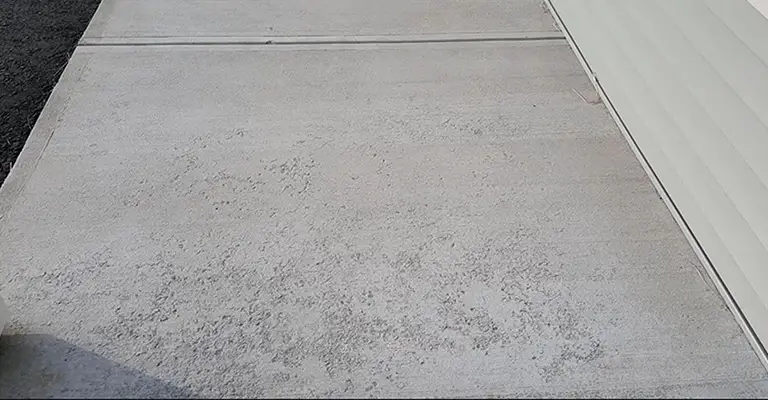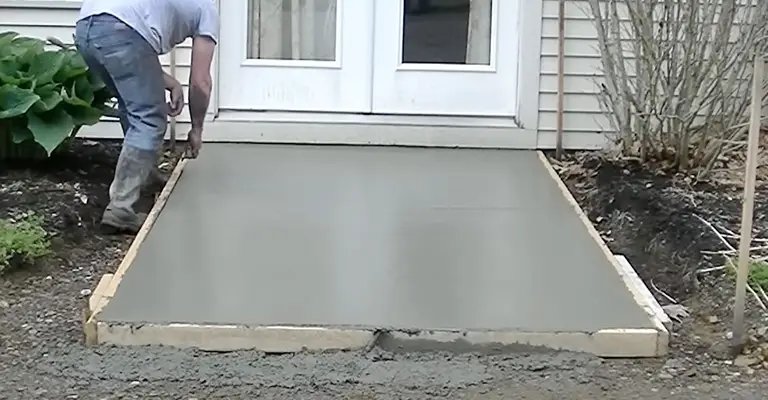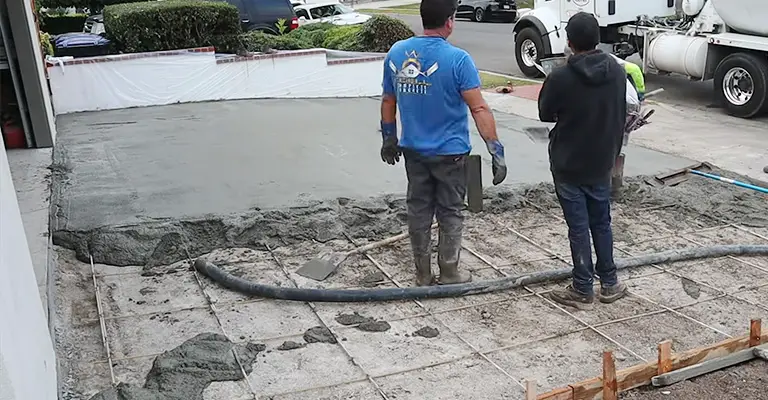A well-executed concrete pour is crucial for the longevity and stability of any construction project. Whether it’s a residential driveway, a commercial foundation, or a sprawling infrastructure project, the quality of the concrete is paramount.
Unfortunately, not all concrete pours meet the required standards, leading to potential problems down the line.
Identifying the signs of a lousy concrete pour is essential to address issues early on and avoid costly repairs or structural failures.
A poorly poured concrete slab can lead to a host of problems, including cracking, uneven surfaces, and weakened structural integrity. Identifying these issues early on can save you time, money, and headaches in the long run.
Even though concrete is one of the most robust building materials, it can be surprisingly delicate, especially when poured and installed.
After the concrete has been poured and set, it may suffer from sun damage and other types of degradation. These damages could occur more frequently if the installation was done poorly initially.
How Do You Know If Concrete Pour Is Bad?

Among the common causes of blemishes on concrete slabs are blisters, cracks, crazing, curling, delamination, discoloration, dusting, efflorescence, low spots, popouts, scaling, and spalling.
Concrete buildings are more suited to earthquake resistance when they are constructed from appropriate building materials.
More importantly, poor concrete installation reduces structures’ overall durability and utility. Poorly installed concrete columns may lead to structural collapse and damaged concrete driveways.
It’s possible that despite your contractor’s best efforts, a variety of factors could undermine the structural integrity of your home. Poorly installed concrete can cause any of the following problems.
Also on this list are the steps you can take to halt further deterioration of your concrete and patch it up to prevent further damage from occurring.
Spalling
A concrete slab that is deteriorating rapidly or poorly installed shows significant spalling. When large chunks of definite fall off, they expose support beams and wires, which the concrete has often concealed.
In the case of delamination, spalling occurs when a layer that has already separated completely separates from the main structure.
Ice and frost cause spalling, similar to potholes, during the freeze-thaw cycle. A concrete mix ordered correctly, and a properly cured structure are two ways to ensure that concrete doesn’t delaminate and eventually cracks.
Additionally, it is vital to keep the system dry while it cures to prevent moisture from building up inside the concrete and freezing.
Cracking
It is probably not surprising that cracks occur when shoddy concrete is poured. Tensile stress on a structure is the most common cause of cracks in dried concrete.
The weight of the surface settling on one end can result in the material settling on that end, or it can be caused by miscalculations of the material’s strength or even violent movements like earthquakes.
Depending on the crack, it can remain only on the surface or extend through the membrane. To prevent cracking in concrete, it is essential to use the correct calculations and the proper materials.
It is important to understand that concrete types have different capacities when it comes to tensile stress. It is also essential to have an inner support structure, as this prevents most of the stress from being applied to the brittle concrete itself.
A professional should evaluate concrete structures with hairline cracks immediately to identify how best to brace them and distribute the stress.
Honeycombing

Poor craftsmanship shows up as multiple air pockets and voids in the concrete. In reality, these can be dangerous gaps are hidden deep within the cement, which may look like rough surfaces on the outside.
Whenever there are gaps in the materials between the particles, honeycombing can occur. This is caused by improper tamping and the contractor’s inability to completely fill the areas.
A honeycomb pattern is complicated to detect after removing the concrete forms, indicating the cement has already been set and dried.
In a concrete structure, the degree of honeycombing is determined by how deep the air pockets and voids are.
Concrete will only be prevented from honeycombing if it is properly tamped down after it has been poured.
It is also important to check whether your contractor used enough aggregate materials, such as sand or gravel, to fill any potential air pockets.
Delamination
Concrete delamination occurs when pieces separate substantially from other layers but remain attached to the structure for the most part. While it may appear stable and solid, the piece is ready to break off.
Tapping on delaminated areas can help you identify them. It’s hard to say whether a hollow, echoey thump has separated the concrete, but it does indicate there was a space behind it.
When concrete delaminates, deep cracks in the structure’s interior or buckling of supports embedded inside are the causes.
Concrete deterioration can also happen when new concrete is laid on top of dilapidated older concrete, usually to patch up the damage.
Delamination can only be prevented by ensuring the concrete’s interior support structure is strong enough to withstand damage. A proper adhesive and attachment to older concrete layers should also be maintained.
Bleeding
During bleeding, moisture and water leak from poured concrete to the surface while heavier deposits settle to the bottom. It creates either thin slices of water or puddles of water when water is forced up.
The strength of cement is undermined by too much water, mainly if it’s used for the foundation or support columns, causing some bleeding whenever concrete is settling.
After the cement has fully dried, excessive bleeding can indicate that too much water has leached into it, which could lead to all sorts of problems.
The bleeding or oversaturation of water can be prevented in two ways. It’s important to ensure that no groundwater or rainwater seeps into the concrete your contractor just poured.
During this process, it is essential to keep an eye on the weather and the soil condition.
Furthermore, one should pay attention to the ratio between concrete and water. A certain amount of water must be added to the mix to make concrete malleable without oversaturating it.
Causes Of Poor Concrete Installation

The U.S. is famous for poor concrete installation being one of the leading causes of building collapses.
Construction defects and poor workmanship were the leading causes of building collapses in 225 building collapses over 11 years.
In addition to these adverse conditions, other factors also contribute to them. In the following paragraphs, we discuss some of the most common reasons concrete does not set properly during installation.
Bad Weather
During the concrete setting process, heat and dryness are required. The importance of this is especially important for structural elements such as foundations and support pillars.
During adverse weather events such as rainstorms and floods, concrete installations can become saturated, reducing their strength.
In light of this, professional concrete installers and contractors are extremely careful when they decide what time and month to pour their concrete.
The majority of contractors avoid wet months and winter because of the high humidity and risk of water leeching into the concrete.
Sometimes summer storms and rain will indeed happen anyway, so professional contractors will often use tarps to prevent fluid from infiltrating concrete.
Wrong Water
However, water is still essential to making concrete viscous and moldable, regardless of how dangerous too much water may be for concrete installations.
It is important, however, that contractors use the right water when putting cement together to ensure it will last.
Researchers found that saltwater (mixed with sea sand and other aggregates) made building structures especially vulnerable to earthquake collapse.
In the process of eroding the concrete, the salt in the water eats through the metal bars, causing pillars to break and walls to crack.
You should make sure your contractors are not using high salt water if you live near the coast to avoid this problem.
Poor Materials
Apart from water, you should also ensure that all the other materials used in pouring the concrete are of high quality. For example, the sand you mix with the concrete must not be infiltrated with other particles.
Besides high-quality and secure concrete forms, your contractor must also use certain forms. It is possible for your structure to warp and even buckle if the concrete forms are shoddy.
In addition, the steel support rods, and similar materials embedded inside the concrete should also be optimized. Its strength will be compromised if the structure is not constructed from these materials.
Shoddy Technique
The skills of the laborer’s could also contribute to the quality of the concrete pour. Moreover, not every contractor hires workers with enough experience to know the best weather for pouring concrete.
A builder who builds durable concrete forms does not have the patience to do so. Several unscrupulous contractors may also cut corners for the sake of saving time or padding their own pockets.
Finding an experienced contractor who can be trusted to do the job is just as important as preventing water infiltration.
The Bottom Line
Like all building materials, you must mix and apply concrete with care if you want it to be one of the most robust materials you can use. It is possible to put your structure’s occupants at risk through poor craftsmanship or careless installation.







